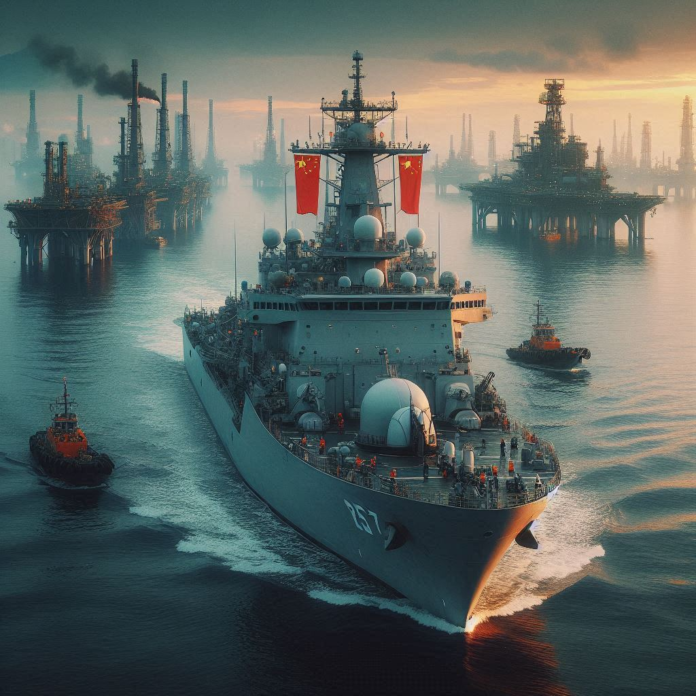The sighting of a Chinese frigate in Malaysia’s Exclusive Economic Zone (EEZ), near an oil platform in Sarawak, has raised alarm in the region. The South China Sea, already a hotbed of territorial disputes, is experiencing heightened tensions due to the presence of heavily armed Chinese warships. This incident, which involves a Chinese warship entering Malaysian waters, underscores the growing concerns about national security and regional stability.
Jiangwei II Class 053H3 light frigate
The Chinese frigate involved in this incident has been identified as a Jiangwei II Class 053H3 light frigate, a warship known for its versatility and combat readiness. Part of China’s modernization of its naval fleet, the Jiangwei II Class 053H3 is equipped with advanced weaponry, including anti-ship missiles, air defense systems, and torpedoes. It serves both as a deterrent and a combat-ready vessel capable of engaging in naval warfare.
The Jiangwei II Class 053H3 was designed with a range of roles in mind, from escort duties to anti-submarine operations. This particular class of frigates, introduced in the late 1990s, reflects China’s efforts to expand its naval capabilities and project power beyond its immediate territorial waters. The frigate’s anti-ship missiles, such as the YJ-83, give it the ability to strike enemy vessels at considerable distances, while its air defense systems offer protection against aircraft and incoming missile attacks. Additionally, the ship’s torpedo systems allow it to target submarines, making it a versatile threat in both surface and underwater combat scenarios.
Watch Video: China Warns Malaysia Over Sarawak
The sighting of this warship in Malaysian waters represents a marked escalation from previous incursions, which typically involved less threatening maritime patrol vessels. The Jiangwei II Class 053H3, with its array of modern weaponry, indicates a more assertive posture by China in the region. Its presence near the Sarawak oil platform has caused serious concern, as it showcases China’s ability and willingness to deploy warships with significant firepower into contested areas.
Concerns Over National Security
Malaysia’s defense community has emphasized that the sighting of a Chinese warship in its waters should not be taken lightly. While China has intruded into Malaysian waters before, this incident is different due to the nature of the vessel involved. The Jiangwei II Class 053H3 frigate’s presence near the Sarawak oil platform has prompted questions about the adequacy of Malaysia’s defense capabilities in protecting its territorial waters.
The South China Sea is rich in natural resources, including oil and gas, and is one of the world’s most important shipping routes. Control over this region offers both strategic and economic advantages, which is why the area is highly contested. China’s assertiveness in the region, especially its deployment of warships like Jiangwei II into areas claimed by other nations, is seen by many as a demonstration of its military might and determination to dominate the area.
China Warns Malaysia Over Sarawak as Diplomatic Note Leaks in Filipino Newspaper
While China has not directly provoked Malaysia in the way it has with countries like the Philippines and Vietnam, its actions are still viewed as a significant threat. The fact that the Chinese warship turned off its Automatic Information System (AIS) before entering the area adds to the sense of unease. This makes the ship’s location difficult to track, further complicating the situation for regional security forces.
Need for Modernization
The appearance of a heavily armed Chinese warship in Malaysia’s EEZ has sparked calls for the modernization of the Malaysian Armed Forces, particularly the Royal Malaysian Navy. Analysts argue that Malaysia’s defense capabilities are not keeping pace with the evolving threats in the region. The slow process of upgrading military assets has left Malaysia vulnerable, especially as China continues to assert its presence in disputed waters.
The Jiangwei II Class 053H3 frigate’s presence highlights the gap in naval capabilities between Malaysia and China. While Malaysia has deployed its own navy and maritime patrol vessels to monitor the situation, the advanced technology and firepower of the Chinese frigate serve as a reminder of the growing military imbalance in the region. This has led to increased pressure on the Malaysian government to prioritize defense spending and accelerate the modernization of its naval fleet.
Malaysia Inches Closer to China Amid Rising South China Sea Tensions
There is a growing consensus among defense experts that the Malaysian government needs to prioritize the modernization of its military assets. This includes speeding up the acquisition of new naval vessels and other critical defense equipment. As China continues to deploy advanced warships like Jiangwei II into contested areas of the South China Sea, countries like Malaysia must ensure that their armed forces are capable of defending their territorial waters.
While China’s presence in the region may not have escalated to open conflict, the situation remains tense. The deployment of warships near critical infrastructure like oil platforms raises the stakes and could potentially lead to more serious confrontations in the future. For now, Malaysia is responding by sending its own navy and maritime patrol vessels to monitor the situation, but the gap in capabilities between the two countries is a cause for concern.
In conclusion, the recent sighting of a Chinese Jiangwei II Class 053H3 frigate near Sarawak has increased tensions in the South China Sea, highlighting the ongoing struggle for control over the region’s valuable resources and strategic waterways. While no direct confrontation has occurred, the presence of advanced Chinese warships in Malaysia’s EEZ underscores the need for Malaysia to strengthen its defense capabilities to ensure its national security.


